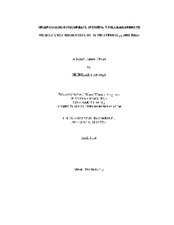| dc.description.abstract | Angiogenesis, the formation of new blood vessels, is important in growth, healing, and disease. Sphingosine-1-phosphate (S1P) is a lysophospholipid with potent angiogenic effects. One of these effects is its regulation of cellular migration, an early step in angiogenesis. S1P exerts contradictory effects on different types of vascular cells, strongly inducing endothelial cell (EC) migration while strongly inhibiting vascular smooth muscle cells (VSMC) migration. Here, we demonstrate that S1P inhibits the migration of VSMCs by activating G[α]₁₂ and RhoA. S1P abolished the migration of VSMCs in response to platelet-derived growth factor (PDGF), a potent stimulator of VSMC migration. PDGF strongly induced the formation of lamellipodia, which are membrane ruffles associated with cell migration. S1P eliminated these and induced the formation of stress fibers, which are actin cytoskeletal structures that stabilize the cell. The members of the Rho family of small GTPases regulate cytoskeletal morphology and function. Rac1 induces lamellipodia, RhoA induces stress fibers, and Cdc42 induces filopodia, which are small finger-like membrane spikes. We introduced dominant-negative (DN) and constitutively active (CA) mutants of the Rho GTPases into VSMCs using adenoviral vectors. The results indicated that S1P inhibits VSMC migration by activating RhoA. RhoA activation was also demonstrated directly using a RhoA pull-down assay. S1P exerts its cellular effects by activating the endothelial differentiation gene G-protein-coupled receptors, which initiate signaling pathways by activating different G[α] subunits of heterotrimeric G proteins. To determine which G[α] subunit S1P activates in order to activate RhoA, we introduced DN and CA mutants of G[α]₁₂ and G[α]₁₃ into VSMCs through adenoviral vectors. The results indicated that S1P activates RhoA by activating G[α]₁₂. These results are important because they further elucidate some of the key signaling pathways regulating angiogenesis. When angiogenesis begins, ECs migrate in response to S1P and other factors. Interestingly, our new data suggest that S1P may prevent VSMCs from interfering with early EC tube assembly, by inhibiting VSMC migration through selective activation of G[α]₁₂ and RhoA. Later, after the ECs have established a network of capillary tubes, they secrete additional factors, such as PDGF, which attract VSMCs to them, allowing mature blood vessels to form. | en |


